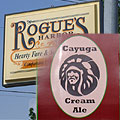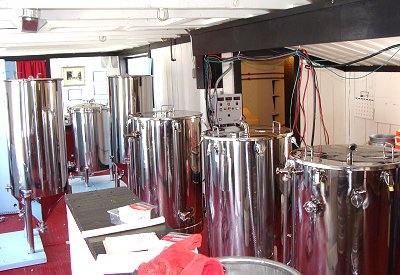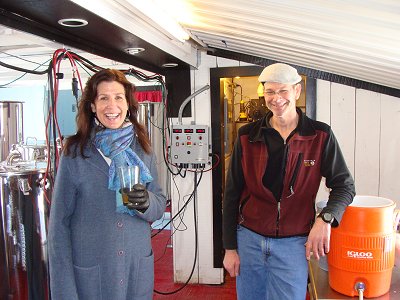- By Dan Veaner
- Around Town
 Print
Print  There is evidence as well as stories that the Rogue's Harbor Inn made liquor for its customers during Prohibition. That is part of the mythology that got the inn it's roguish name. Over the past three months owner Eileen Stout has been putting together the pieces she'll need to revive that tradition. This time the inn will be opening a microbrewery to make beer for Rogue's Harbor patrons. Stout says she hopes to launch the new beer in a couple of weeks with a whole week of events, including free tastings and pint glasses, half price growlers, live music, and brewery tours.
There is evidence as well as stories that the Rogue's Harbor Inn made liquor for its customers during Prohibition. That is part of the mythology that got the inn it's roguish name. Over the past three months owner Eileen Stout has been putting together the pieces she'll need to revive that tradition. This time the inn will be opening a microbrewery to make beer for Rogue's Harbor patrons. Stout says she hopes to launch the new beer in a couple of weeks with a whole week of events, including free tastings and pint glasses, half price growlers, live music, and brewery tours.This week Stout and brewer Chris Williams were busy making test batches, getting supplies, and putting together the Rogue's Harbor Brewing Company in the wooden building next to the inn. Most recently that building housed the Lansing Fresh Cafe, and before that Gimme Coffee!, and a jewelry/antiques shop before that. While the brewery is starting modestly with only one beer, Stout is already looking to the future.
"We've got plenty of room," Stout says. "And we're not bottling, we're just kegging. Bottling is a whole 'nother process, really."
To start, the beer will only be available in the Inn. Patrons will be able to order it inside the inn, or in growlers to take home. Williams will be brewing one kind of beer to start with, Cayuga Cream Ale. Cream ale is a straw colored, lightly hopped, sweeter style of beer that is a little more carbonated than regular beer. Williams has been making test samples, which he and Stout are testing along with Stout's husband Cliff Babson. Williams says he's also let others in the 'brewers' underground' taste it to get more opinions before they begin producing it in earnest.
"We chose a cream ale because it is a truly American brewing style which gained popularity in this very region, and it is a food friendly crowd pleaser," Stout says.
Williams has a long history of home brewing, and has worked for Custom BrewCrafters in Rochester. He also does video and computer work. Stout found him by happenstance. He had come to the inn to sell her something else and they got to talking.
"He found me," she says. "I had decided to brew and he just walked in the place one day. He said I know a thing or two about brewing beer, and I said, do you?!"
 (From front to back) The first tank heats wate, the next one brews the sweet liquid, and the third is for adding hops. The next two are for fermentation, and the last adds the bubbles.
(From front to back) The first tank heats wate, the next one brews the sweet liquid, and the third is for adding hops. The next two are for fermentation, and the last adds the bubbles.To start with Williams will work part time, but if the operation grows it could become a full time job. For now the brewery consists of six tanks capable of making a maximum of 960 pints of beer at a time. The first tank makes hot water. That is pumped into the second tank, which makes the sweet liquid by steeping the grains in the water, like tea. That is pumped into the third tank and hops is added. The hops, a bittering agent, you add in the third tank determines the sweetness and bitterness balance in the beer.
The beer is brewed in the first three tanks for only a couple of hours, and is then pumped into one of the two fermenting tanks. Yeast is added to consume the sugar and convert it into carbon dioxide and beer. Fermentation takes approximately two weeks. By the end of the first week the yeast population has grown exponentially, and as the food supply diminishes it goes dormant and starts to drop to the conical bottom of the tank, from which it can be separated from the finished beer. The last step is to pump the beer into the 'bright tank,' in which it is carbonated. That step takes about 24 hours.
The final step is to put the beer in kegs and carry them into the inn so it can be served to patrons.
The plan is to perfect the first beer before deciding what kind the second one will be. The pair are taking it one step at a time, perfecting each step before going on to the next one.
 Rogue's Harbor Inn and Brewing Company owner Eileen Stout with Brewer Chris Williams
Rogue's Harbor Inn and Brewing Company owner Eileen Stout with Brewer Chris Williams"Our goal is to create a consistent product, so that every time you have a glass of it, it's the same," Williams says. "There are a lot of variables involved. We'll be adjusting things and figuring this out in the first few weeks. I think we have a very good recipe. Now we're scaling it up. So the first goal is to maintain and keep producing a consistent product. After we've got that process down we'll start to think about another ship to sail."
Stout says she is enjoying the process of creating this new business, despite the reams of paper work and time it takes not only to get the right equipment set up, but also to procure the three licenses she needs from New York State and the federal government. Originally she hoped to be brewing in June, but she seems satisfied that all the Is are dotted and Ts crossed for her February launch. (Check the Lansing Star Events Calendar or IthaCalendar.com where opening events will be posted once the final dates are decided upon.) That will begin a whole new chapter for the inn that Stout is looking forward to.
"I think when people take a big gulp and smile -- that will make me happy," Stout says.
----
v7i5



